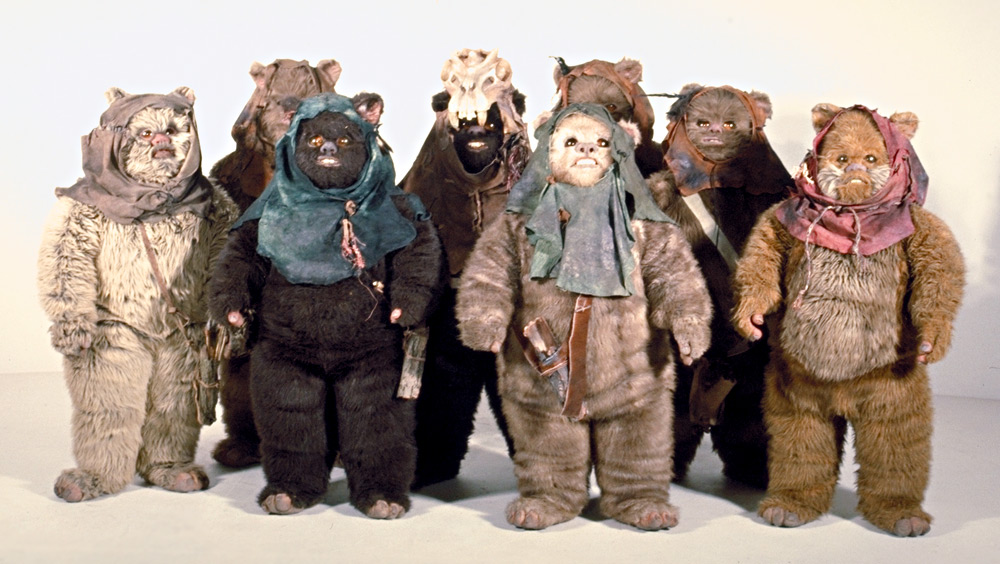A few weeks ago when I tried to find some analysis of the mysterious and baffling novella "And Seven Times Never Kill Man!" by GRRM, Google turned up a series of articles about how George Lucas "stole" an illustration for this story to create his Chewbacca. The case originates from and is convincingly argued here by Binary Bonsai.
The illustration on the cover of Analog (July 1975) was by the famed sci fi artist John Schoenherr, who also did the extremely influential illustrations for Dune.
Star War's art designer Ralph McQuarrie mentioned being given a sci fi magazine cover by Lucas, which significantly helped define the image of Chewbacca during the pre-production for SW.
Of course, besides the appearance, there is probably no thematic correlation between Chewbacca the character and GRRM's novella. It couldn't anyway, since the script for SW was probably finished when the novella was published. However, Elio Garcia, the host of westeros.org and the authoritative living encyclopedia of all things ASOIAF, noted an obvious parallel between the story and a key plot in Return of the Jedi. (Alas, Elio is not an encyclopedia of SW and mistakenly called Ewoks as Wookies.)
The story of Ewoks strongly echos that of the Jaenshi in "And Seven Times Never Kill Man!" The Jaenshi is a kind of intelligent non-human species living on a jungle planet. The illustration by Scheonherr above is a Jaenshi.
Analog describes the story as "realities of a very rigid
society conflicting with what looks like a pushover primitive tribal
society; and we find out where the strength really lies." Yes, the Jaenshi don't have screechers, laser handguns, or blast cannons. They are clearly based on all the pushover tribes that have been colonized throughout human history. Such encounters of civilizations have served as the inspiration for many such stories. No wonder the story resonated with Lucas. I agree with Elio Garcia that Lucas was probably influenced GRRM's story, consciously or unconsciously, when he wrote ROTJ's Ewok story line, which was written in the early 1980s.
Perhaps ROTJ tries to rewrite GRRM's bleak story and fulfill our own dream of the underdogs beating the big bad wolf. I can understand this urge. The same routine is recycled once again a couple of decades later by James Cameron in Avatar. Of course, Avatar also more substantially ripped off Disney's animated movie "Pocahontas", as illustrated by someone apparently named Matt Bateman. But still. The connection to ROTJ and Ewoks is there too.
I do wonder if Cameron has read "Seven Times" though, because Avatar also lifts a certain mystical "collective consciousness" that was hinted at in the story. OK, perhaps such a concept need not come from GRRM. Isaac Asimov described such a planetary consciousness in his Foundation series known as Gaia (written in the early 1980s). This series eventually merged with his Robot series. Similar ideas may be widespread in the sci fi community. In GRRM's story, however, the planetary consciousness is not at all clearly described. In fact he worked really heard to conceal it. Still, in Avatar the natives prayed to and connect to the trees, which is not unlike the Jaenshi priests rubbing their godly pyramids.
Anyway, regardless, all of these examples of a non-human and possibly collective consciousness represented in different ways by GRRM, Asimov, or Cameron (but not Lucas) may have come from an original source. The oldest source I can find is Solaris by the Polish conceptual sci fi writer Stanislaw Lem. Solaris was written in 1961 but translated to English only in 1970. Surely at least GRRM and Asimov would have been exposed to it. The mysticism in Solaris in some ways must have also influenced GRRM. Comparatively, however, GRRM is more earthly and humanistic. In 1975 he was not yet 30 and I doubt he can ever be as detached or philosophical as Lem is. His satire of militarism, religious fanaticism, and egoism is evident in "Seven Times." He must have been thinking of the Vietnam War and the conservative political forces at the time. (Ironically, 40 years and a few more wars later, the American conservatives remain much the same, thus keeping the story as fresh as it was then.)
Both GRRM and Lucas were of the Vietnam War generation, so it might be another reason the story left such an impression on the latter.
On a side note, although we humans instinctively reject the idea of a collective consciousness outside of our own consciousness, how could we know for sure? Much convincing argument has been made about the illusion of free will. If the Greenseer is able to reach anywhere in space and time and all creatures and minds, how could we ever tell what is our own mind and what is that planted by the Greenseer with the old gods? (Readers of ASOIAF would get this reference.)




No comments:
Post a Comment